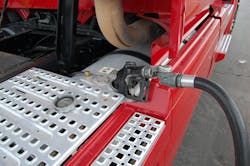National average retail prices for both diesel and gasoline continued to decline this week, according to data tracked by the Energy Information Administration (EIA), with the agency also projecting that U.S. demand for petroleum will “remain flat” for the next quarter century in part due to rising fuel economy standards for motor vehicles.
Diesel prices dipped 9/10ths of a penny this week to a national average of $2.414 per gallon, EIA reported, which is 40 cents cheaper per gallon compared to the same week in 2015.
Prices declined in every region of the U.S. except for the Rocky Mountains, where diesel increased 9/10ths of a penny to $2.445 per gallon, while prices in California stayed flat week-over-week at $2.798 per gallon.
Gasoline prices declined 3.8 cents to a national average of $2.253 per gallon, noted EIA, which is 58.1 cents per gallon cheaper compared to the same week in 2015.
Prices for gasoline dropped in every region of the U.S., the agency added, with the biggest one-week dips occurring in the Midwest (down 5.3 cents to $2.155 per gallon) and New England (down 4.7 cents to $2.276 per gallon).
In related news, EIA's Annual Energy Outlook 2016 indicated that three so-called “fossil fuels” – petroleum, natural gas, and coal – provided more than 80% of total U.S. energy consumption for more than 100 years and, making up 81.5% of total U.S. energy consumption last year, but are projected to dip down to 76.6% by 2040 due to a range of laws and policies.
In EIA's “reference case” projection, petroleum consumption is expected to remain “similar to current levels” through 2040, as fuel economy improvements and other changes in the transportation sector offset growth in population and travel.
Coal consumption is expected to keep declining, especially in the electric power sector, as consumption dipped 13% in 2015 – the highest annual percentage decrease of any fossil fuel in the past 50 years, the agency said.
The EIA noted that “biomass” consumption, which includes wood as well as liquid biofuels like ethanol and biodiesel, is expected to remain relatively flat, as wood use declines and biofuel use increases slightly over the next quarter century.
About the Author
Sean Kilcarr
Editor in Chief
Sean Kilcarr is a former longtime FleetOwner senior editor who wrote for the publication from 2000 to 2018. He served as editor-in-chief from 2017 to 2018.
